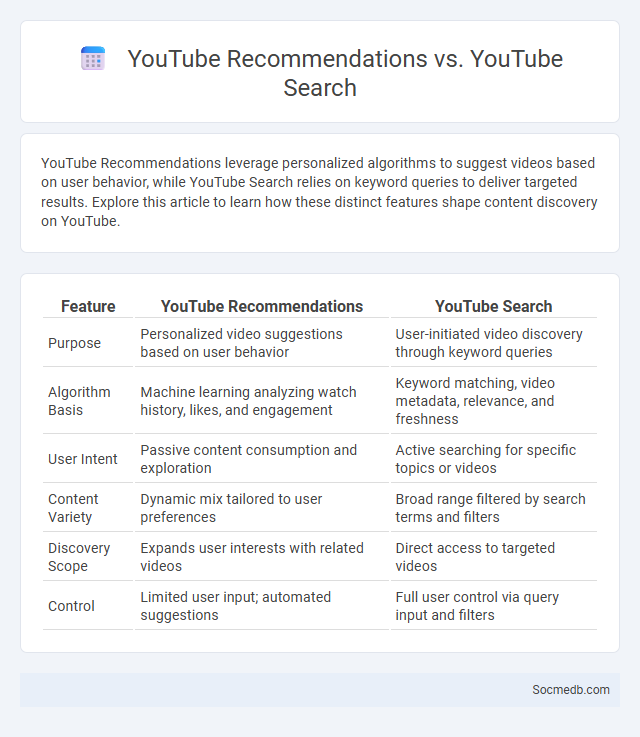
Photo illustration: YouTube Recommendations vs YouTube Search
YouTube Recommendations leverage personalized algorithms to suggest videos based on user behavior, while YouTube Search relies on keyword queries to deliver targeted results. Explore this article to learn how these distinct features shape content discovery on YouTube.
Table of Comparison
| Feature | YouTube Recommendations | YouTube Search |
|---|---|---|
| Purpose | Personalized video suggestions based on user behavior | User-initiated video discovery through keyword queries |
| Algorithm Basis | Machine learning analyzing watch history, likes, and engagement | Keyword matching, video metadata, relevance, and freshness |
| User Intent | Passive content consumption and exploration | Active searching for specific topics or videos |
| Content Variety | Dynamic mix tailored to user preferences | Broad range filtered by search terms and filters |
| Discovery Scope | Expands user interests with related videos | Direct access to targeted videos |
| Control | Limited user input; automated suggestions | Full user control via query input and filters |
Understanding YouTube’s Recommendation Engine
YouTube's recommendation engine uses advanced machine learning algorithms to analyze your viewing history, search queries, and engagement patterns to suggest personalized content. This system prioritizes watch time and viewer retention, promoting videos that keep users engaged longer. Understanding this can help you tailor your content strategy to increase visibility and reach on the platform.
How YouTube Search Works
YouTube Search uses advanced algorithms that analyze video titles, descriptions, tags, and viewer engagement to deliver relevant results. Machine learning models evaluate user behavior, watch history, and trending topics to personalize search outcomes. The platform continuously updates its indexing system to prioritize content quality, relevance, and freshness in search rankings.
Recommendations vs Search: Key Differences
Recommendations on social media rely on personalized algorithms that analyze Your preferences, interactions, and behavior to suggest relevant content, while search involves actively entering specific queries to find targeted information or profiles. Recommendations optimize discovery by predicting what You might enjoy, whereas search provides direct control over the information You seek. Understanding these key differences enhances Your ability to navigate platforms effectively and maximize the value of social media engagement.
The Role of Algorithms in YouTube Recommendations
YouTube's recommendation algorithms analyze user behavior, watch history, and engagement to deliver personalized video suggestions that maximize viewer retention. These algorithms use machine learning models to predict content relevance and optimize recommendations for increasing watch time, driving both user satisfaction and platform revenue. By continuously adapting to user interactions, the system ensures a dynamic, tailored content feed that enhances user experience and encourages longer session durations.
User Intent: Browsing vs Searching on YouTube
Understanding user intent on YouTube reveals that browsing is driven by casual exploration and content discovery, while searching targets specific information or entertainment needs. Your viewing experience varies with browsing favoring algorithmically suggested videos, whereas searching relies on precise keywords to yield relevant results. Optimizing content for both intents involves balancing engaging thumbnails and titles with keyword-rich descriptions to capture diverse audience behaviors.
Content Discovery: Recommended Videos vs Search Results
Content discovery on social media hinges on two primary methods: recommended videos and search results. Recommended videos leverage complex algorithms analyzing Your viewing history, engagement patterns, and trending topics to personalize content suggestions, enhancing user retention and satisfaction. In contrast, search results provide direct access based on keyword queries, offering precise control over the content You want to explore, balancing algorithm-driven discovery with intentional selection.
Personalization: How Recommendations Adapt to Viewers
Social media platforms utilize advanced algorithms to tailor content recommendations based on your past interactions, preferences, and viewing habits. Machine learning models analyze patterns such as likes, shares, and watch times to dynamically adapt the feed, enhancing relevance and engagement. This personalized approach ensures that the content you see aligns closely with your interests, maximizing platform satisfaction and user retention.
Impact on Creators: Recommendations vs Search Visibility
Social media algorithms heavily influence creators' success by prioritizing recommendations over search visibility, driving more engagement through tailored content feeds. Your reach and growth depend on how well your content aligns with trending topics and user preferences showcased in recommendation systems. Optimizing content for these algorithms enhances discoverability and strengthens audience connection beyond traditional search methods.
Viewer Engagement: Do Recommendations Outperform Search?
Viewer engagement on social media is significantly higher through personalized recommendations compared to traditional search methods. Algorithms analyzing your interaction history deliver content tailored to your preferences, increasing the likelihood of prolonged viewing and interaction. Understanding the superior performance of recommendations can help optimize your content strategy for maximum engagement.
Best Practices for Optimizing Videos for Both Systems
Optimizing videos for social media platforms requires attention to aspect ratios, resolutions, and auto-play settings to ensure maximum engagement across systems like Instagram and Facebook. You should use subtitles, compelling thumbnails, and concise, clear messaging tailored to each platform's algorithm to increase reach and retention. Prioritizing mobile-friendly formats like vertical videos and leveraging platform-specific features drive higher visibility and interaction on your content.
 socmedb.com
socmedb.com